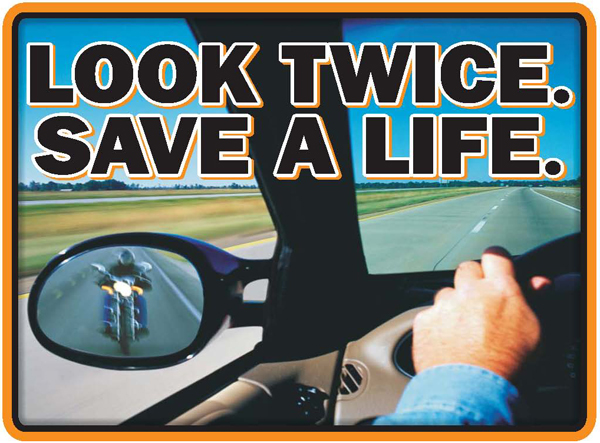Motorcycles vs. Cars
For as long as motorcycles and cars have travelled together on the roadways, there has existed contention between some who ride motorcycles and some who don’t. There are those of us who have been riding motorcycles for years and do so responsibly; I have  been riding for 15 years and never had an accident. Yet there are also some drivers who have been exposed to the small number of motorcyclists who take advantage of their maneuverability to weave in and out of traffic, ride too closely, drive too fast, or otherwise engage in reckless behavior. The true responsibility for motorcycle accidents is probably somewhere in between the two dissenting opinions.
been riding for 15 years and never had an accident. Yet there are also some drivers who have been exposed to the small number of motorcyclists who take advantage of their maneuverability to weave in and out of traffic, ride too closely, drive too fast, or otherwise engage in reckless behavior. The true responsibility for motorcycle accidents is probably somewhere in between the two dissenting opinions.
A 10-year study performed by the University of South Florida’s Center for Urban Transportation Research found that most of the time, the motorcyclists are right – 60% of vehicle/motorcycle accidents are the result of the vehicle failing to yield the right-of-way. This having been said, motorcycles are not off the hook either according to the statistical data. The same study also revealed that motorcyclists have a much higher incidence of single vehicle accidents. This means that even without the interference of cars or trucks, 34% of the time, motorcycles crash on their own.
The billboards and bumper stickers that warn us to watch out for motorcycles are numerous and there is a good reason for that. Nearly 90% of all motorcycle accidents result in injuries. This is 30% greater than the number of injuries that result from car accidents. Additionally, a motorcycle accident is 35 times more likely to result in a fatality according to one newspaper report. The state with the greatest number of motorcycle fatalities? You guessed it – the Sunshine State. Specifically, three of the top seven Florida counties where motorcycle fatalities occur are in South Florida. These statistics exist in spite of the fact that Florida requires each motorcyclist to take a motorcycle safety course. This is because as anyone who has ever driven a motorcycle knows, driving one is very different than driving a car.
There are more than a 500,000 motorcycles registered in the State of Florida. Add to that the thousands more who descend upon the state as the result of the multiple annual motorcycle enthusiast events held here in Florida. These events, such as the state-sponsored Biketoberfest and Daytona Bike Week, and the sheer volume of people who attend them increases the potential for motorcycle accidents tremendously. Yet, even with the throngs of enthusiasts migrating into the area for these events, 90.2% of the motorcycle injuries that occur involve Florida riders. The reason for this statistic is unclear, but the message that it sends is loud and clear. Both motorcyclists and those operating cars in Florida need to be more aware of, and more courteous to, each other.
In every state, with the exception of California, it is illegal to weave a motorcycle in and out of traffic. Although it’s tempting to try to negotiate between stopped cars when baking in a traffic jam in the South Florida sun, if a police officer sees you, you will probably get a ticket. This is considered reckless driving and can result in you being charged with a third degree misdemeanor.
Likewise, popping a wheelie, which every motorcyclist has done, will also result in a stiff traffic citation and four points against your license. In fact, the consequence of the first offense of popping a wheelie will result in a fine of $1,141 and a second offense will result in a fine that more than doubles that amount. A third offense and you could lose your license. I am all for cops enforcing laws that help protect the vast majority of citizens, but I feel that when it comes to motorcyclists, both our legislators and cops tend to view them in a negative light. To impose such stringent penalties over something that can happen on a motorcycle due to the simple action of losing traction with the road seems extreme and supersedes the punishment governing even reckless driving.
There are things that you as a motorcyclist can do to alleviate the possibility of getting a ticket or worse, sustaining injuries, and there are many things that drivers can do to reduce the risk of injuries to motorcyclists.
As a motorcyclist, make sure that you have your motorcycle endorsement on your driver’s license. As I have indicated, cops often need little incentive to issue citations to motorcyclists and not having the proper endorsement can result in not only a citation, but in your not being able to ride the bike home, thereby having it impounded. Another important tip to remember is to make sure that you can be seen by wearing bright clothing with reflective material. Choice of clothing is important not just because it helps you to be seen, but the proper gear prevents injuries. This is South Florida – the state of shorts and t-shirts. Even though motorcycle helmet usage was repealed more than 10 years ago, data shows that fatalities from head injuries are reduced by as much as 50% by wearing a helmet. Furthermore, oftentimes motorcyclists don’t think about the other injuries they can sustain if they wreck a motorcycle. Exposed arms, legs, and hands can all suffer injuries if your bike goes down.
Another important consideration is to make sure that you are alert. It is extremely dangerous to drive while drowsy under any conditions, but inherently more so when driving a motorcycle. Always be aware of your route before you leave for your destination. Last minute turns or uncertainty can increase the likelihood of an accident, as can construction debris, poor signage, or even poorly maintained roads. Although this is true whether you are in a car or on a motorcycle, as previously stated, the fatality rate increases exponentially for those operating a motorcycle. The State of Florida’s motorcycle safety course can help you to prepare for these types of obstacles and to deal with them with a higher level of success.
There are many approaches that a driver of a car or truck can make to avoid causing injuries to motorcyclists. Always make sure that you leave room for motorcycles. Even though they are lower profile vehicles than cars, they still need the room to maneuver that a full traffic lane provides. Check your mirrors and blind spots frequently to ensure they are clear. Make sure to always yield the right-of-way to motorcycles, and also keep in mind that motorcycle turn signals do not automatically turn off, so you can’t be sure if one is turning or if the motorcyclist just neglected to turn it off.
No matter your feelings about motorcyclists, no one wants to be responsible for injuries, or worse, to those with whom they share the road. This can be avoided by following the few suggestions that I have made here and driving courteously. Motorcyclists need to remember that they are more vulnerable than when they are in a car. Drivers of four-wheeled vehicles need to look twice and maintain a safe traveling distance. If however, you get a traffic citation on either a motorcycle or other vehicle, please call the Traffic Ticket Team for a free consultation.

FREE CONSULTATION
866-433-3363
Call now or contact us for a fast, free, no obligation consultation.

